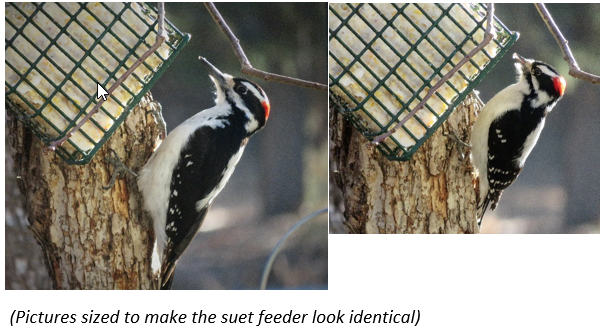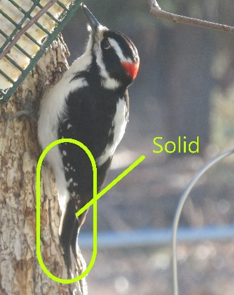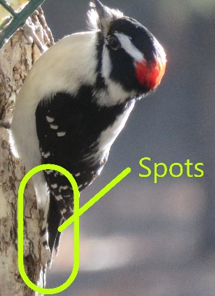By Sue Sitko
In the over four decades (ouch!) I’ve been a birder, I’ve gotten pretty good at calling a Hairy Woodpecker a Hairy Woodpecker and a Downy Woodpecker a Downy Woodpecker. I’ve seen both hundreds of times. For me it comes to the “jizz” (feel and look of the bird) than anything else. At our house, we mostly get Hairy’s. I would say 99 times out of 100, the Hairy/Downy-looking woodpecker at our feeders will be a Hairy.
I know this from a few diagnostic markers that scramble together in my brain, which spits out “it’s a Hairy!” However, lately, we’ve had a pair of Downy Woodpeckers regularly visiting our feeders, and I found myself stumbling on the specific differences of each when asked by my husband “which one is which?”
It just so happened that one morning, both made an appearance at the same place at our suet feeder, and I was able to get photos of each. So let’s take a look!



As you can see from these two comparison images, using the suet cage as a marker, the Hairy Woodpecker is approximately 50% larger than a Downy. A Hairy is medium-sized, averaging 9” in length (think of a Townsend’s Solitaire or a slender American Robin) and a Downy is more like our Western Bluebird, averaging about 6” in length.
In the above images, perhaps one of the easiest diagnostic markings is the size of the bill relative to the bird’s length of the head. A Downy’s bill is tiny; at times when flitting around or pecking at suet, you can barely see it. A Downy’s bill is approximately the same length as the distance from the base of the bill to its eye. Whereas the Hairy’s bill is an obvious power tool. It is darker, with its length equivalent, nearly, to the entire length of the head.
Another key mark is to look at the outer tailfeathers, which are white with black spots on the Downy and plain white on the Hairy. Check it out!
I was fortunate to have these male woodpeckers (red markings on the head) visit the same suet feeder within a few minutes of each other, letting me capture both birds with my camera. In researching a bit more, I found out that the Downy’s call is a “quiet, friendy ‘pic’” while a Hairy’s diagnostic “pic” call is stronger and louder, more like an attention-grabbing squeaky dog toy.
So, if our yard Downy pair is any indication of a few more Downy’s in our area, you may come across them. And if so, take a closer look at the overall size, the ratio of beak to head length, and if possible, the outer tail feathers (spots versus plain). And you, too, will soon get the “jizz” of both the Hairy and Downy and will be able to identify them in an instant!